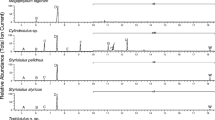Abstract
Adults of the lubber grasshopper (Romalea guttata) secrete increased amounts of catechol from their defensive glands when fed diets containing only catnip leaves (Nepeta cataria). Model compound bioassays showed that these insects were able to sequester and biomagnify simple phenols, such as catechol and hydroquinone, in their defense gland secretions. Excessive catechol secretions from caffeic acid-fortified diets indicated metabolic pathways exist to perform efficiently more complex biochemical conversions. Reverse-phase HPLC of methanol extracts of catnip revealed only one major caffeoyl-polyphenol as a possible precursor for the observed elevated catechol secretions, when this plant is fed to lubbers. The compound was shown to be caffeoyltartronic acid (CTA). During analysis of CTA by probe-MS or gas chromatography (of its silylated derivative), CTA decomposed by loss of carbon dioxide to form caffeoylglycolic acid (CGA), making identification by these methods ambiguous. Only fast atom bombardment mass spectrometry (FAB-MS, negative mode) gave a true molecular weight. Groundivy (Glecoma hederacea), a relative of catnip, was also shown to contain CTA. The mung bean (Phaseolus radiatus=Vigna radiata), a species totally unrelated to catnip, is the only other reported plant source of CTA. Catnip leaves were found to contain about twice as much CTA as mung bean leaves.
Similar content being viewed by others
References
Blum, M.S. 1981. Chemical Defenses of Arthropods. Academic Press, New York. 502 pp.
Blum, M.S., Whitman, D.W., Severson, R.F., andArrendale, R.F. 1987. Herbivores and toxic plants: Evolution of a menu of options for processing allelochemicals.Insect Sci. Appl. 8:459–463.
Blum, M.S., Severson, R.F., Arrendale, R.F., Whitman, D.W., Escoubas, P., Adeyeye, O., andJones, C.G. 1990. A generalist herbivore in a specialist mode.J. Chem. Ecol. 16:223–244.
Duffey, S.S. 1980. Sequestration of plant natural products by insects.Annu. Rev. Entomol. 25:447–477.
Horvat, J., andSenter, S.D. 1980. A gas-liquid Chromatographic method for analysis of phenolic acids in plants.J. Agric. Food Chem. 28:1292–1295.
Jones, C.G., Hess, T.A., Whitman, D.W., andBlum, M.S. 1987. Effects of diet breadth on autogenous chemical defense of a generalist grasshopper.J. Chem. Ecol. 13:282–297.
Jones, C.G., Whitman, D.W., Compton, S.J., Silk, P.J., andBlum, M.S. 1989. Reduction in diet breadth results in sequestration of plant chemicals and increases efficacy of chemical defense in a generalist grasshopper.J. Chem. Ecol. 15:1811–1822.
Kolodynska, Z., andWieniawski, W. 1967. Preparation of caffeoylglycolic acids.Acta. Pol. Pharm. 24:261–265.
Morita, H. 1972. Identification of phenolic acids by gas chromatography-mass spectrometry.J. Chromatogr. 71:149–153.
Petersson, G. 1972. Mass spectrometry of hydroxy dicarboxylic acids as trimethylsilyl derivatives. Rearrangement fragmentations.Org. Mass Spectrom. 6:565–576.
Rothschild, M. 1972. Secondary plant substances and warning colouration in insects, pp. 59–83,in H. van Emden (ed.). Insect/Plant Relationships. Blackwell, Oxford.
Sondheimer, E. 1964. Chlorogenic acids and related depsides.Bot. Rev. 30:667–712.
Strack, D., Hartfield, F., Austenfeld, F.A., Grotjahn, L., andWray, V. 1985. Coumaroyl-, caffeoyl- and feruloyltartronates and their accumulation in mung beans.Phytochemistry. 24:147–150.
Author information
Authors and Affiliations
Rights and permissions
About this article
Cite this article
Snook, M.E., Blum, M.S., Whitman, D.W. et al. Caffeoyltartronic acid from catnip (Nepeta cataria): A precursor for catechol in lubber grasshopper (Romalea guttata) defensive secretions. J Chem Ecol 19, 1957–1966 (1993). https://doi.org/10.1007/BF00983799
Received:
Accepted:
Issue Date:
DOI: https://doi.org/10.1007/BF00983799




